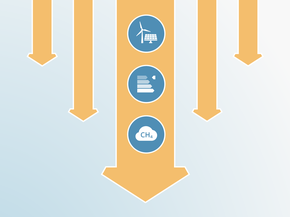Country summary
Overview
Egypt is slowly emerging from its economic crisis, during which climate action has seen limited progress. While the government has set an ambitious renewable energy target of 42% by 2030, deployment has largely stalled in recent years. Instead, the government is moving ahead with plans for massive fossil gas expansion and continues to place fossil gas at the centre of its energy strategy, a move which risks locking the country into a high-emissions pathway.
Egypt’s emissions are projected to continue rising through 2035, and its current climate commitments will do little to reverse this trend, as they are set at a level above that which is already expected under current policies. A first step towards improvement for Egypt would be to establish clear, transparent, and more ambitious targets that can effectively drive emissions down. The upcoming 2035 NDC submission offers a crucial opportunity to reset climate action, but significant international support will be critical to turn stronger commitments into real progress. The CAT continues to rate Egypt’s overall climate action as “Highly Insufficient”.
Egypt’s 2030 NDC targets are problematic, as they do not include an economy-wide emissions reduction target but instead present reductions in only three sectors: electricity, transport and oil & fossil gas. Rather than committing to a measurable reduction in total emissions below a base year, Egypt presents emission reductions relative to a projected business-as-usual scenario. This approach lacks transparency and makes it difficult to track progress.
Egypt’s targets are also unambitious as they are set above the emission levels already expected under current policies. This means Egypt can already overachieve its targets with existing policies alone, without the need for additional, more ambitious policies. Neither does Egypt have any unconditional targets that it would achieve without international financial support. The new round of 2035 NDC submissions offers Egypt an opportunity to present transparent, measurable and ambitious targets.
Egypt’s continued prioritisation of fossil gas development risks undermining its already weak climate commitments. The government has committed USD 7.2bn to new fossil gas exploration to meet domestic energy and export demand, while promoting fossil gas as a “bridging fuel” across nearly all sectors of the economy. This strategy risks locking the country into a high-carbon pathway and increasing the likelihood of stranded assets, making it more difficult to decarbonise the economy in line with the Paris Agreement. In contrast, a transition away from all fossil fuels, coupled with accelerated renewable energy deployment, could bring multiple benefits, including steady emissions reductions, enhanced energy security, economic diversification, and new employment opportunities.
Despite reaffirming its commitment to achieving a 42% share of renewable energy in its electricity generation mix by 2030, progress on renewable energy deployment remains slow. In 2024, renewables made up just 11% of the country’s electricity mix. Planned wind and solar projects reflect huge potential, but progress is hindered by several structural challenges, including grid infrastructure limitations to integrate a higher share of variable renewables, as well as a currency devaluation that has increased the capital cost of imported components. Egypt has reaffirmed its commitment to its 2030 target but has clearly stressed that achieving it will require substantial international climate finance.
Egypt’s 2024 National Strategy for Low-Carbon Hydrogen aims to position the country as a regional hydrogen and ammonia hub, with ambitious export-oriented targets, targeted incentive schemes, and over USD 33bn in announced investments. While it holds potential for decarbonising hard-to-abate sectors like steel and fertilisers, the inclusion of blue hydrogen(i.e., produced from fossil gas combined with carbon, capture and storage) and the heavy emphasis on exports raise concerns. Without significant renewable energy deployment and safeguards to prioritise domestic decarbonisation, Egypt risks falling short on its green hydrogen production and broader energy transition goals.
Efforts across other sectors signal early progress, but implementation gaps remain. Key measures needed for strengthening Egypt’s climate action include:
- Submit new ambitious NDC targets: Egypt should submit revised and more ambitious 2030 (and 2035) NDC targets that shift away from a BAU-based approach to a reduction approach below a historical base year. These targets should include both unconditional and conditional components, with clear emission reduction commitments across all sectors – that go beyond what is already expected under current policies.
- End fossil gas expansion: The government should cease plans for expanding fossil gas production and exploration to avoid emissions lock-in and stranded assets.
- Implement renewable energy reforms: Addressing systemic barriers to renewable energy scale-up through coordinated reforms.
- Focus on green hydrogen: Explicitly excluding fossil-based hydrogen in its national strategy and focusing solely on renewable-powered green hydrogen.
Despite the overall lack of sufficient climate action, there have been several positive developments worth highlighting:
- With a view to reduce its fiscal burden, Egypt is implementing comprehensive energy sector reforms that include the gradual removal of subsidies on both electricity and petroleum products, as part of a broader national economic reform program The country has significantly reduced its fossil fuel subsidy burden to its national budget, by setting up targeted social protection schemes. and in line with its commitments under the IMF’s loan agreement (Reuters, 2025a). The main objectives are to reduce fiscal burdens, pro
- Public transport improvements, including metro line extensions, monorail development, and a new BRT system, are expected to reduce emissions in major urban areas.
Description of CAT ratings
The CAT rates each country’s targets and policies against (1) its fair share contribution to climate change mitigation considering a range of equity principles including responsibility, capability, and equality, and (2) what is technically and economically feasible using modelled domestic pathways which, in absence of a better method, are based on global least-cost climate change mitigation.
Comparing a country’s fair share ranges and modelled domestic pathways provides insights into which governments should provide climate finance and which should receive it. Developed countries with large responsibility for historical emissions and high per-capita emissions, must not only implement ambitious climate action domestically but must also support climate action in developing countries with lower historical responsibility, capability, and lower per-capita emissions.
The CAT rates Egypt’s climate targets and policies as “Highly Insufficient”. This rating indicates that Egypt’s climate policies and commitments are not consistent with the Paris Agreement’s objectives and lead to rising, rather than falling, emissions. If all countries were to follow Egypt’s approach, warming could reach over 3°C and up to 4°C.
Egypt’s conditional 2030 NDC targets are rated as “Critically insufficient” when compared to modelled domestic pathways. The “Critically insufficient” rating signals minimal to no action and is not at all consistent with the 1.5°C temperature limit. If all countries were to follow Egypt’s approach, warming would exceed 4°C.
Egypt has not included an unconditional target in its latest NDC update. In the absence of such a target, the CAT takes Egypt’s estimated 2030 emissions under a business-as-usual (BAU) scenario. Egypt’s BAU trajectory is rated as “Highly Insufficient” compared to their fair-share contribution. As a country with lower responsibility, capability, and per-capita emissions, Egypt should receive international support to set an ambitious conditional NDC target beyond its national fair share and implement the policies necessary to achieve it.
To get a better rating, Egypt needs to set more ambitious climate targets and establish associated policies that can curb the growth in national emissions and set them on a downward trend.
The CAT rates Egypt’s policies and action as “Almost Sufficient” when compared to their fair-share contribution to climate change mitigation. The “Almost sufficient” rating indicates that Egypt’s climate policies and action in 2030 are not yet consistent with limiting warming to 1.5°C but could be, with moderate improvements. If all countries were to follow Egypt’s approach, warming could be held at—but not well below—2°C.
Egypt’s continued prioritisation of fossil gas development risks undermining its climate commitments. The government has committed USD 7.2 bn to new fossil gas exploration to meet domestic and export demand, promoting gas as a “bridging fuel” across nearly all sectors. This strategy risks locking Egypt into a high-carbon pathway and increasing the likelihood of stranded assets.
Despite reaffirming its 42% renewable energy target for 2030, deployment remains slow. In 2024, renewables made up just 11% of the electricity mix. Outdated grid infrastructure and high capital costs from currency depreciation continue to hinder progress. Egypt has emphasised that international finance will be essential to meet its targets.
The 2024 National Strategy for Low-Carbon Hydrogen aims to position Egypt as a regional hydrogen and ammonia hub, backed by over USD 33 bn in investments. While promising for decarbonising heavy industry sectors, the central focus on exports and the inclusion of blue hydrogen raises concerns. Without scaling up renewable energy and prioritising domestic decarbonisation, Egypt risks falling short of both its green hydrogen production and broader energy transition goals.
The rating of Egypt’s policies and action has improved from “Insufficient” to “Almost sufficient”. Importantly, this adjustment does not indicate any actual improvement in Egypt’s policies compared to our previous assessment. Rather, this reflects a literature update to our fair share (FS) ranges, aligning our equity approaches with international environmental law and excluding studies based solely on cost-effectiveness. We also incorporated additional recent studies to capture the latest research in the field.
See full summary of policies and actions here.
The CAT rates Egypt’s 2030 NDC conditional target as “Critically insufficient”. Egypt's NDC includes a conditional mitigation target comprised of a quantified emissions reduction below a business-as-usual scenario in three sub-sectors (electricity, transport and oil & gas) as well as a qualitative list of policies and measures in other sectors. The lack of transparency makes the target difficult to assess. The CAT estimates that the target would lead to emissions rising substantially, up to 40% above 2023 levels, and that it will be overachieved with already implemented policies.
The “Critically insufficient” rating signals minimal to no action and is not at all consistent with the 1.5°C temperature limit. If all countries were to follow Egypt’s approach, warming would exceed 4°C.
The rating of Egypt’s conditional NDC target has deteriorated compared to our previous assessment due to an update in our modelled domestic pathways to the pathways assessed in the IPCC AR6. Our newer pathways better capture national circumstances and for higher temperature levels show less room for emissions growth than the previous set.
Egypt has not included an unconditional target or component in its second NDC update. In the absence of such a target, the CAT takes Egypt’s estimated 2030 emissions under a business-as-usual scenario as its unconditional commitment and rates it as “Highly insufficient”.
The “Highly insufficient” rating indicates that Egypt’s NDC target is not at all consistent with any principle of fairness, like responsibility, capability, or equality. If all countries were to follow Egypt’s approach, warming could reach over 3°C and up to 4°C. Egypt would need to roughly stabilise emissions at today’s levels to meet its fair share of the global mitigation effort to keep temperature rise below 1.5°C.
The rating of the BAU against fair share has improved from “Critically Insufficient” to “Highly Insufficient”. Importantly, this adjustment does not indicate any actual improvement in Egypt’s climate targets compared to our previous assessment. Rather, this reflects a literature update to our fair share ranges, aligning our equity approaches with international environmental law and excluding studies based solely on cost-effectiveness. We also incorporated additional recent studies to capture the latest research in the field.
Egypt does not have a net zero target.
Further analysis
Latest publications
Stay informed
Subscribe to our newsletter




